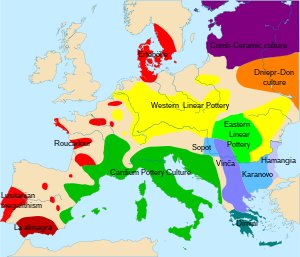La Almagra culture

La Almagra culture ( Spanish la almagra , 'red ocher ,' ' red chalk ' ) is characterized by its red-colored pottery, which was found in a number of archaeological sites of the Neolithic period on the Iberian Peninsula .
In the sixth millennium BC In BC Andalusia saw the arrival of the first arable farmers . Their exact origin remains uncertain, although cultures from North Africa are taken into account. The settlers came with an already developed culture (domesticated forms of grain and legumes ). The presence of domestic animals remains uncertain, but pig and rabbit scraps have been found in abundance, and although these may be wild animals, their sole consumption seems to show some preference. People also consumed large amounts of olives . Whether the olive tree was (semi-) cultivated or completely harvested from its wild form also remains open.
Their typical artifact is the “La Almagra ceramic style”. Spherical vessels have been found in caves near Seville , Cádiz , Málaga , Córdoba and Granada . On the other hand, cylindrical ones are less common. They were found in burial caves near Huelva , Cádiz and Almería .
The Andalusian Neolithic influenced other surrounding areas, especially cultures in southern Portugal and a few centuries later. The construction of the first dolmen tombs there began around 4800 BC with increasing Neolithic times . A.
literature
- Mariano Torres Ortíz: Sociedad y mundo funerario en Tartessos. Real Academia de la Historia, Madrid 1999, p. 68. ISBN 978-84-89512-48-1 .
- Pablo Atoche Peña: La cerámica a la almagra de la Cueva de la Carigüela (Pinar, Granada). Secretariado de Publicaciones. Universidad de La Laguna. 1985-1987.
- V. Galván Martínez, J. Galván García: Las almagras de Almizaraque . Centro de ciencias medioambientales (CSIC).
- Robert Chapman: Emerging Complexity: The Later Prehistory of South-East Spain, Iberia, and the west Mediterranean. Cambridge University Press, 1990, pp. 37-39, ISBN 0-521-23207-4 .
- J. Capel, F. Huertas, A. Pozzuoli, J. Linares: Red ocher decorations in Spanish Neolithic ceramics: a mineralogical and technological study. Journal of Archaeological Science 33 (2006) 1157–1166 [2]
Web links
- Encarnacion Rivero Galán: La ceramica a la Almagra en Andalucia ensayo tipico. Pp. 453-480 [3]
Individual evidence
- ↑ English La Almagra Pottery culture
- ↑ V. Galván Martínez, J. Galván García: Las Almagras of the Almirzaraque: Composición mineralógica, tecnológica y proceso de cocción (PDF; 1.9 MB) Centro de ciencias medioambientales (CSIC)
- ↑ Michael Art: The Neolithic of the Iberian Peninsula. In: Michael Blech; Michael Koch; Michael Art: Monuments of the Early Period. Hispania Antiqua, Mainz 2001 [1]